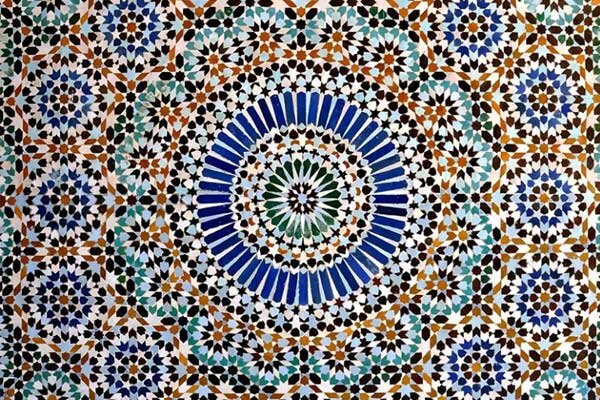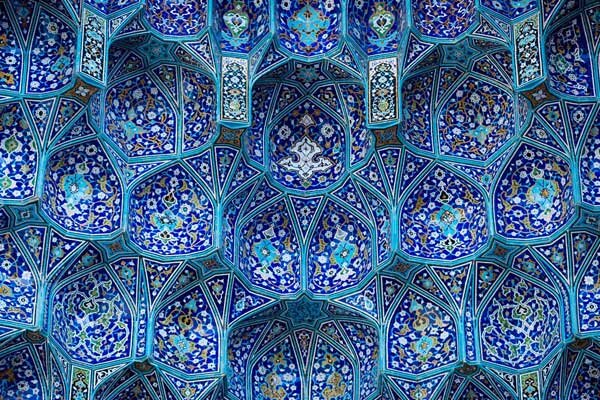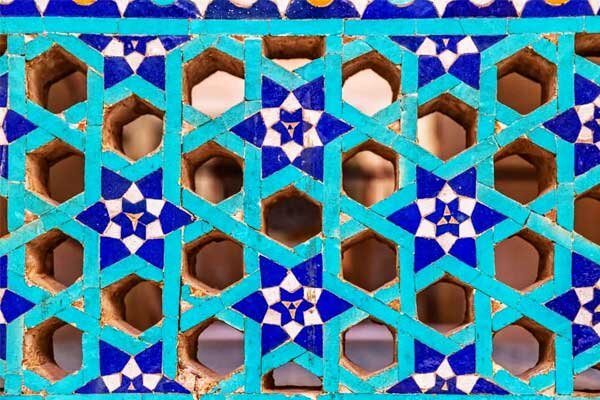Interesting facts about Islamic geometric patterns!

Bearing distinctive features, Islamic geometric patterns are an exemplary art form showcasing intricate designs found in various aspects of everyday life - from mosque decorations to carpets and ceramics. These creations hold both aesthetic value and symbolic significance within the Islamic faith.
Dating back to the early Islamic period, these designs were developed using a set of mathematical principles. Islamic art was characterized by utilizing geometric patterns in a distinct manner owing to various influences. One such impression came from the likes of Greek mathematicians along with Persian and Indian traditions.
Due to this synthesis of ideas, Islamic craftsmen developed a unique artistic style which primarily depended on creating intricate designs using different types of symmetries like mirror symmetry, rotational symmetry as well as translation symmetry achieving equilibrium through just one element. When it comes to Islamic art, symmetry is more than just an embellishment – it holds a significant meaning behind the utilization. Apart from being visually attractive, it represents the equilibrium present in the natural world.
These patterns also often incorporate geometric shapes, such as circles, squares, and triangles, which are repeated and overlapped to create intricate designs. These shapes are not only aesthetically pleasing, but they also hold symbolic significance within Islamic art. For example, the circle represents unity and infinity, while the square represents stability and balance.
In addition to geometric shapes, Islamic geometric patterns often include calligraphy which makes it special. Persian and Arabic calligraphy are considered to be two of the highest forms of Islamic art, and they are often incorporated into geometric designs to create a sense of harmony and balance between the written word and the visual image.
The use of these patterns is not limited to art and architecture. These patterns are also found in Islamic religious texts, such as the Quran and Hadith, as well as in everyday objects such as prayer mats and clothing. In Islamic culture, the use of geometric patterns is seen as a way to connect with the divine and to represent the unity and harmony that exists within the Islamic faith. Islamic geometric patterns are a unique and beautiful form of Islamic art that has been developed over centuries.

Islamic geometric patterns meaning
Islamic geometric patterns hold deep symbolic meaning within the Islamic faith. Here are some of the meanings associated with these patterns:
- Unity: Islamic geometric patterns are used to represent the unity of Allah or God, as well as the unity of the Muslim community. The use of geometric shapes and symmetry in these patterns is thought to symbolize the harmony that exists in the whole universe.
- Infinity: The circle is a common shape in these patterns and is often used to represent infinity. The use of circular shapes in Islamic art and architecture is meant to convey the idea that Allah is eternal and limitless.
- Protection: Islamic geometric patterns are sometimes used as a form of protection, such as in the design of amulets or talismans. These patterns are believed to have protective properties and may be used to ward off evil spirits or negative energies.
- Order and Harmony: Islamic geometric patterns are based on complex mathematical principles and are used to create a sense of order and balance or harmony in Islamic art and architecture. The use of symmetry and repetition in these patterns is meant to create a deep meaning in the design.
- Spiritual Connection: These patterns are used to show a sense of spiritual connection between the viewer and Allah. These beautiful designs of patterns are thought to inspire contemplation and reflection on the divine.
You can get more information about these patterns in Saeidshakouri site.

Types of Islamic geometric patterns
Here are some of the most common and important types of these patterns:
- Arabesque: This type of pattern is characterized by the use of intertwining floral and foliage designs which is a great symbol. It is commonly found in Islamic architecture and decorative arts in the middle eastern countries.
- Interlacing: Interlacing patterns are created by overlapping and interweaving lines. These patterns can be very meaningful. They are commonly used in Islamic calligraphy as well.
- Star and polygonal patterns: These patterns are created by repeating geometric shapes to create beautiful designs. These patterns are commonly found in Islamic tile work as well and are used to create decorative designs in mosques and etc.
- Calligraphy: Calligraphy is a type of Islamic art that involves writing the Arabic and Persian script in a decorative and artistic way. Calligraphy is often used in conjunction with other types of Islamic geometric patterns to create beautiful and meaningful designs. We can see this art in the Quran and Persian poems.
where are Islamic geometric patterns used?
Islamic geometric patterns are used in a variety of contexts, including:
Islamic Architecture
Islamic geometric patterns are commonly found in Islamic architecture, including mosque domes, facades, and minarets. These patterns are used to decorate walls, ceilings, and floors of mosques and other Islamic buildings. You can travel to the middle east to see this special art.
Decorative Arts
These patterns decorate a wide range of decorative arts, including textiles, tiles, ceramics, glassware, and metalwork. These patterns are used to create special designs on everyday objects such as plates, bowls, vases and etc.
Islamic geometric patterns in carpets and jewelry
These patterns are used widely in carpet design, with special patterns in the fabric of the carpets. These carpets are in mosques and other Islamic buildings as prayer mats and they are very expensive. Also, these carpets are a great option for Muslims in their interior decoration.
These patterns are also used in jewelry designs, including rings, bracelets, and necklaces that creates decorative designs in precious metals such as gold and silver. You can buy these things in middle eastern countries.
In conclusion, Islamic geometric patterns are an important part of Islamic art and culture, used in a wide range of contexts to create beautiful designs.
